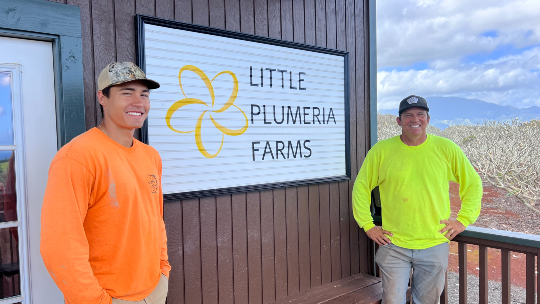There are no limits when it comes to fashion. From wacky, over-the-top looks on the runway to classy, elegant pieces on the red carpet, designers let their imagination and creativity run wild. But their process always begins with finding inspiration.
Designer and artist Page Chang draws from nature and her Hawaiian heritage. She was born and raised in Washington, D.C., but as an adult, she moved to Oahu to get in touch with her roots.

Page Chang working with kapa. Photo courtesy Pukoa Studios
“I craved knowledge,” says Chang. “I felt like I missed out on belonging and that childhood connection to Hawaii because I wasn’t born here.”
During her quest to learn more about her heritage, Chang found a kumu who taught her about kapa, the traditional Hawaiian fabric.
“My original goal was to share Hawaiian culture through art. And kapa helped pull me into that,” says Chang, who started creating jewelry, hatbands, and other wearable kapa. “I wanted people to see there’s so much more to Hawaii than hibiscuses or hula dolls.”

Earrings, bracelets, and pouches made from kapa. Photo courtesy Pukoa Studios
While Chang practiced and honed her skills as a kapa maker, she still had a passion for oil painting and printmaking. She needed a space for all this creativity and that’s when she opened Pukoa Studios.
Connecting with art and nature
Pukoa means coral reef in Hawaiian. Chang’s father gave her the name as an adult.
“He said he chose it because the reef is always creating and growing, like me,” explains Chang. “I named my studio Pukoa for the same reasons: I envisioned it as this space to nurture not just my own artistic passions, but also for other artists.”
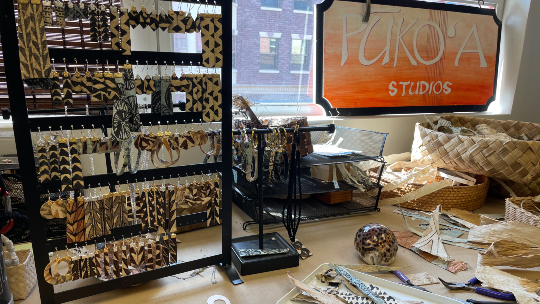
Creative minds at work inside Pukoa Studios. Photo courtesy Pukoa Studios
Sustainability is at the core of Pukoa Studios. Chang grows wauke (paper mulberry) plants in her yard in Waimanalo, using the inner bark to produce kapa. She also makes natural dyes out of the plants in her garden. Even the packaging is made from coconut fiber, recycled fabric, and organic hemp.
“Without sustaining our water, air, and land, we can’t live,” says Chang. “My work wouldn’t exist without sustainability. It takes me back to the aina and helps me recognize the value in our natural world.”
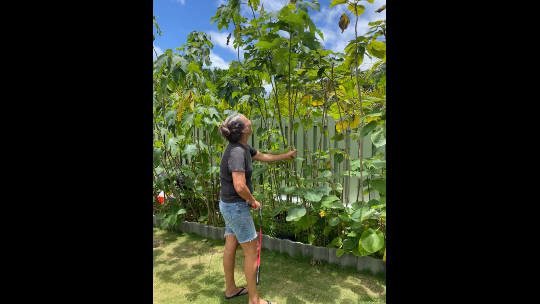
Chang with wauke plants in her yard. Photo courtesy Pukoa Studios
Inspiration behind the art
Making kapa is a long, complicated process. It involves stripping the bark of wauke, leaving the inner bark fibers, which are soaked, pounded, and fermented. Once it’s soft, it’s pounded again into sheets of kapa. From there, the designer is free to create to their heart’s desire.
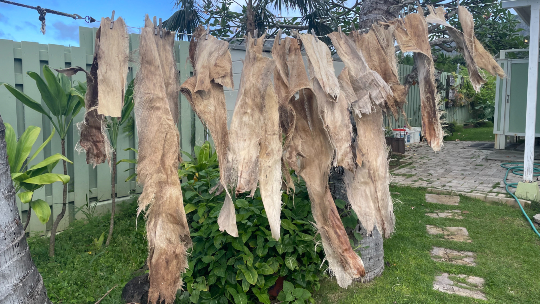
Coconut fiber drying in Chang's yard. Photo courtesy Pukoa Studios
“I investigate each fiber and ideas will just come to me,” says Chang. “More than anything, it’s working with the material and looking at the pattern, repetition, and surface design.”
The color of her creations depends on the season and what the plants provide.
“Last year’s olena harvest was horrible, so I didn’t have yellow for most of the year,” says Chang. “So I have to think, ‘What do I have available to me right now? And what can I create with that?’”
Chang is also inspired by the world around her, especially traditional and contemporary Hawaii-influenced designs. She recently painted her daughter diving for squid on kapa.
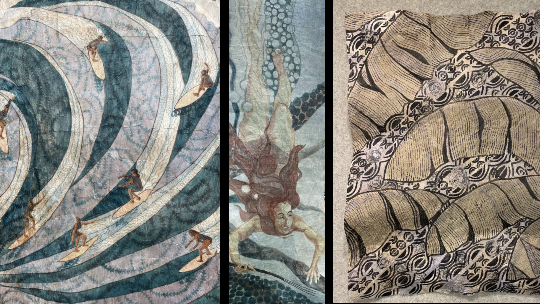
Chang's kapa art includes her daughter diving for squid (middle). Photos courtesy Pukoa Studios
“I combined the modern aesthetic of kapa with more representational imagery, which comes from my painting background,” explains Chang.
Perpetuating Hawaiian culture
Chang isn’t just an artist; she’s also now a kumu in kapa, offering workshops that teach participants how to create their own unique pieces. She hopes to inspire the next generation to take up this ancient art.
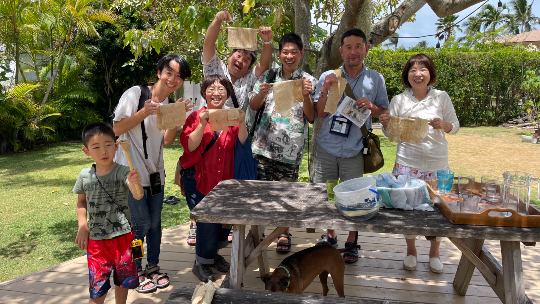
Workshop participants showing off their kapa. Photo courtesy Pukoa Studios
“Pukoa Studios represents authentic Hawaiian practice and themes,” says Chang. “I’m trying to show our youth that we can perpetuate these practices and succeed doing so.”

